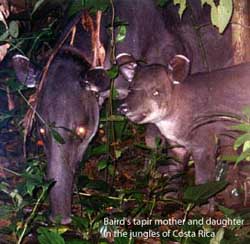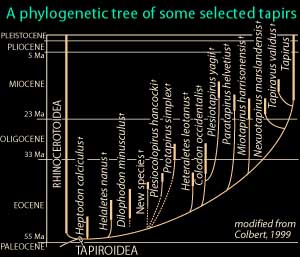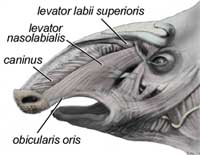Introduction
 Click on images for larger views. The four living species of tapirs ( Tapirus terrestris- the lowland tapir, T. pinchaque- the mountain tapir, T. bairdii- Baird's tapir, and T. indicus- the Asian tapir) are remnants of an ancient lineage whose evolutionary origin traces back at least fifty million years. Although their stout body superficially makes them look like pigs, and their short fleshy proboscis (trunk) often causes casual zoo-goers to mistake them for anteaters, they are not closely related to either of these groups. In fact, their closest evolutionary cousins among living mammals are rhinoceroses - a relationship well supported by the fossil record. Indeed, some fossil forms occurring near the time of origin of the rhinoceros and tapir lineages are so similar to one another that it is difficult to determine to which group they belong! Click on images for larger views. The four living species of tapirs ( Tapirus terrestris- the lowland tapir, T. pinchaque- the mountain tapir, T. bairdii- Baird's tapir, and T. indicus- the Asian tapir) are remnants of an ancient lineage whose evolutionary origin traces back at least fifty million years. Although their stout body superficially makes them look like pigs, and their short fleshy proboscis (trunk) often causes casual zoo-goers to mistake them for anteaters, they are not closely related to either of these groups. In fact, their closest evolutionary cousins among living mammals are rhinoceroses - a relationship well supported by the fossil record. Indeed, some fossil forms occurring near the time of origin of the rhinoceros and tapir lineages are so similar to one another that it is difficult to determine to which group they belong!
However, when we look at extant tapirs, there are many features that distinguish them from rhinoceroses, as well as from all other mammals.   Among the suite of characters that differentiate tapirs from other mammals, the most obvious are: the continuous transverse shearing blades (or lophs) on their cheek teeth; their three-toed hindfoot, and four-toed forefoot; and most noticably, their short prehensile proboscis (see discussion below). It is the evolutionary changes in these and other features through time, as documented by fossils, that allow us to unravel the evolutionary history and relationships of tapirs. Among the suite of characters that differentiate tapirs from other mammals, the most obvious are: the continuous transverse shearing blades (or lophs) on their cheek teeth; their three-toed hindfoot, and four-toed forefoot; and most noticably, their short prehensile proboscis (see discussion below). It is the evolutionary changes in these and other features through time, as documented by fossils, that allow us to unravel the evolutionary history and relationships of tapirs.
Habits and distribution
 Tapirs are browsers, and the series of transverse shearing blades (lophs) on their cheek teeth are adapted for chewing fruit, leaves, twigs and vines. Tapirs generally live in forested areas, and their stocky build, with relatively short limbs and stout torso, is well suited for barreling through the underbrush. Although they are large mammals, (adult tapirs weighing from about 150-360 kg [330 -800 lbs] - depending on species), they are characteristically shy and avoid human contact. Because of this, and because they are typically crepuscular (active at dawn and dusk) or nocturnal, they are rarely seen in the wild. Tapirs are generally solitary, although several individuals may share an overlapping home range. They have a long gestation period (about 13 months), and they give birth to one calf at a time. This low recruitment rate makes tapirs highly vulnerable to overhunting. Unfortunately, habitat loss and overhunting are major threats to the long-term survival of all four tapir species. Because of its widespread range, Tapirus terrestris is in the best shape of the four, being listed as 'vulnerable' to extinction by the 2002 IUCN red list. The other three species are listed as 'endangered' on the same list. Tapirs are browsers, and the series of transverse shearing blades (lophs) on their cheek teeth are adapted for chewing fruit, leaves, twigs and vines. Tapirs generally live in forested areas, and their stocky build, with relatively short limbs and stout torso, is well suited for barreling through the underbrush. Although they are large mammals, (adult tapirs weighing from about 150-360 kg [330 -800 lbs] - depending on species), they are characteristically shy and avoid human contact. Because of this, and because they are typically crepuscular (active at dawn and dusk) or nocturnal, they are rarely seen in the wild. Tapirs are generally solitary, although several individuals may share an overlapping home range. They have a long gestation period (about 13 months), and they give birth to one calf at a time. This low recruitment rate makes tapirs highly vulnerable to overhunting. Unfortunately, habitat loss and overhunting are major threats to the long-term survival of all four tapir species. Because of its widespread range, Tapirus terrestris is in the best shape of the four, being listed as 'vulnerable' to extinction by the 2002 IUCN red list. The other three species are listed as 'endangered' on the same list.

Excellent summaries of tapir behavior, habits, and a nice gallery of photos can be found at The Tapir Gallery website.
The four living species of tapirs have an unusual distribution, with three species living in the New World, and the Asian tapir in southeast Asia. Fossil tapirs are known from Europe, Asia, and North America. Interestingly, tapirs did not appear in South America, their current stronghold, until the Isthmus of Panama emerged from the sea to connect North and South America. Recent fossil recoveries from Brazil indicate that tapirs were present there around 8 million years ago.
|
Phylogenetic history
 Tapirs are perissodactyls (or odd-toed ungulates), a group that also includes the rhinoceroses and the horses. This evolutionary grouping is well supported by both molecular and morphological data. Relationships of fossil taxa within Tapiroidea (defined as all taxa more closely related to Tapirus terrestris than to Rhinoceros unicornis), however, have been more problematic. Despite these difficulties, and the differences of opinions that different researchers have regarding evolutionary relationships among the tapirs, fossil tapirs clearly illustrate a 'progressive' evolution of many of the skeletal features characteristic of the Recent tapirs, particularly those features correlated with the evolution of their muscular trunk.
Tapirs are perissodactyls (or odd-toed ungulates), a group that also includes the rhinoceroses and the horses. This evolutionary grouping is well supported by both molecular and morphological data. Relationships of fossil taxa within Tapiroidea (defined as all taxa more closely related to Tapirus terrestris than to Rhinoceros unicornis), however, have been more problematic. Despite these difficulties, and the differences of opinions that different researchers have regarding evolutionary relationships among the tapirs, fossil tapirs clearly illustrate a 'progressive' evolution of many of the skeletal features characteristic of the Recent tapirs, particularly those features correlated with the evolution of their muscular trunk.
Phylogenetic analyses of the living tapirs suggest that the New World tapirs are more closely related to one another than they are to the Asian tapir, and that T. terrestris is most closely related to T. pinchaque (Norman and Ashley, 2000). This hypothesis of relationship implies a minimum of one dispersal between the hemispheres to explain their current distribution. |
The tapir's trunk
  The tapir's prehensile trunk is associated with modifications in their skull. These modifications include an extremely retracted narial incision (or nasoincisive incisure), loss of the bony wall of the nasal chamber, and development of scars and tubercles for muscle attachment. These features have been used to infer the presence of a trunk in fossil tapirs. The trunk is comprised of modified muscles of the upper lip and nose, and is capable of complex movements. The reader is referred to a recent paper by L. Witmer, S. Samson, and N. Solounias for a thorough description of the anatomy of the tapir's proboscis (find this citation listed in the references on the Tapirus terrestris page). The tapir's prehensile trunk is associated with modifications in their skull. These modifications include an extremely retracted narial incision (or nasoincisive incisure), loss of the bony wall of the nasal chamber, and development of scars and tubercles for muscle attachment. These features have been used to infer the presence of a trunk in fossil tapirs. The trunk is comprised of modified muscles of the upper lip and nose, and is capable of complex movements. The reader is referred to a recent paper by L. Witmer, S. Samson, and N. Solounias for a thorough description of the anatomy of the tapir's proboscis (find this citation listed in the references on the Tapirus terrestris page).
|
Tapirs on the DigiMorph site
To date, the CT lab at the University of Texas has scanned skulls of three of the four living species of tapirs, and four skulls of fossil tapirs. These scans are part of ongoing research being conducted by Matthew Colbert at The University of Texas. The three scanned living species are T. terrestris-the lowland tapir, T. bairdii- Baird's tapir, and T. indicus-the Asian tapir. Hopefully, the remaining Recent taxon, Tapirus pinchaque- the mountain tapir, will be scanned in the near future. Scanned fossils include two skulls of the Oligocene tapir Colodon from South Dakota, the skull of Protapirus, of Nexuotapirus, and of Hesperaletes, a new genus and species of small tapir from the middle Eocene of San Diego County in California. These fossil scans will be displayed on the DigiMorph site as soon as their scientific descriptions have been published. Plans are also in the works to scan other fossil tapirs, so stay tuned for developments!
Text by Matthew Colbert |

